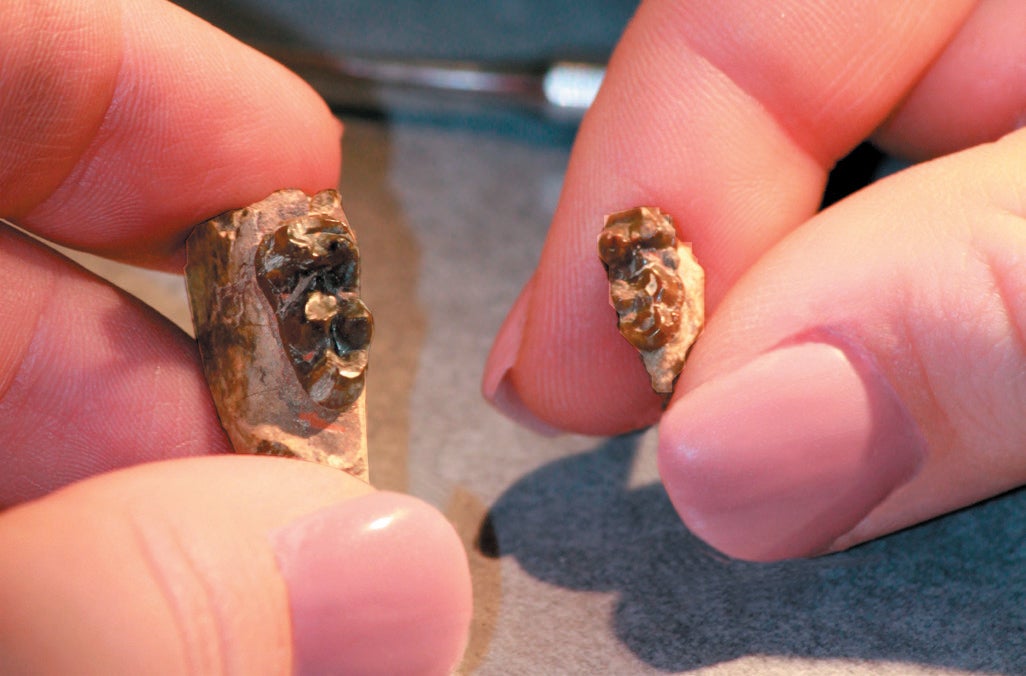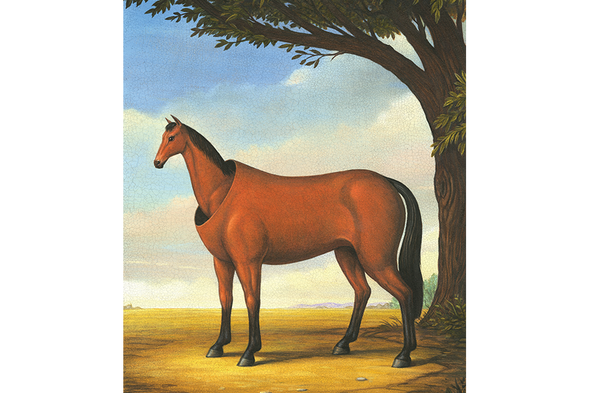The world got hot in a hurry 56 million years ago. In just 10,000 years—an eyeblink of geologic time—temperatures shot up by as much as eight degrees Celsius, according to paleoclimate data. In one swampy lowland that is now part of Wyoming, the average annual temperature reached about 26 degrees C, similar to the humid tropical coasts of today's Indonesia. One of the locals, loping along in the heat, was a small, brownish animal, with pointy ears and long legs made for running. At roughly four kilograms, the creature was the size of a small dog, perhaps a diminutive terrier. It was, in fact, a horse.
Ancient horses were not exactly Arabian stallions before the warming: at about 5.5 kilograms, they resembled tiny antelopes. But they shrank considerably once this period, known as the Paleocene-Eocene Thermal Maximum, began. This particular horse, called Sifrhippus, went down in body size by a staggering 30 percent. And that was not the end of the downsizing, says Abigail D'Ambrosia Carroll, a graduate student in environmental science at the University of New Hampshire, who studies the fossil remains of the animals. During a later warming phase, 53 million years ago, horse sizes shrank again in many lineages, according to research published in 2017. The bodies of other mammals, such as a rabbit-sized creature that was an ancestor of modern deer, got smaller, too.
This link between shrinking animals and rising temperatures is not just ancient history. Many present-day species are declining in size as the planet warms. Common toads have gotten smaller, as have marine iguanas, snakes, tortoises, salamanders, wood rats, dung flies, butterflies in the Arctic, several kinds of North Sea fishes and a species of sheep. The reason for this pattern has puzzled scientists, but an answer is now emerging from various experiments, as well as field observations and fossils. That answer focuses on energy needs: a smaller, less energy-intensive body may confer survival advantages in warmer surroundings, and therefore animals in hotter areas evolve, over many generations, to become smaller. “I think we are getting closer to understanding these mechanisms,” says Janet Gardner, a biologist at the Australian National University in Canberra.
Beyond solving a biological mystery, the growing understanding suggests yet another cause for concern about the effects of climate change. “Smaller sizes could result in extinctions, in the extreme, or disruptions in food webs or other ecosystem-level processes that can directly affect services by animals that benefit humans,” says Michael Sears, an evolutionary biologist at Clemson University. One study has suggested that in the next 30 years, we could see significant shrinking of many of the world's fish species. Although the exact degree of the size change is debatable, many scientists agree it could have serious consequences that ripple up the food web.
The Climate Connection
The fossil record can get quite detailed when it comes to tracing a strong relation between temperature and body size. One animal that left behind a great amount of data is the bushy-tailed wood rat. The width of wood rats' fecal pellets (droppings) turns out to correlate closely with the size of the individual that excreted them. The pellets also fossilize quite well, creating a long record in sediments that can be analyzed year by year. When scientists at the University of New Mexico and the U.S. Geological Survey went through 25,000 years of fecal pellet data in a study published in 1995, they discovered that wood rat body size fluctuated over that time, going up and down in step with climate changes.
Why would such a connection exist? Back in the 19th century, German biologist Carl Bergmann suggested it might have something to do with a need to regulate body heat. He observed that warm-blooded animals in colder, higher latitudes tend to be larger than mammals that lived closer to the equator and have relatively smaller body-surface-to-weight ratios—there are no slender, giraffelike necks or long, ostrichlike legs near the poles. Bergmann hypothesized that it is easier for a mammal to save body heat if its surface-area-to-volume ratio is smaller rather than bigger. (When people curl up to keep snug in the cold, they are minimizing their surface area.) Yet this idea does not account for the variation now observed in insects, fishes and other nonmammals.
.png)
A more complete explanation is emerging from modern laboratory experiments with different kinds of animals: many scientists think the shrinkage may have something to do with changes in animal metabolism and in the food needs that go with it. One thing researchers have observed is that when you put the young of many species in warmer environments, the animals grow faster at first but then mature sooner. As a result, individuals end up at a more modest adult size than they would have in cooler surroundings. (Imagine people maturing at the age of eight; we certainly would all be shorter.) In 2012 Andrew Hirst, an evolutionary biologist now at the University of Liverpool in England, and his colleagues published a meta-analysis of experiments on maturation and temperature in 169 species that live on land or in water. They found that 90 percent are mature at smaller body sizes when temperatures are higher. “It's an incredibly widespread phenomenon,” Hirst says.
Maturation time is intimately tied to metabolism, which increases when the mercury goes up. Metabolism is a chemical reaction, and “chemical reactions just happen faster at higher temperatures than at lower temperatures,” explains Vanessa Messmer, a marine biologist at James Cook University in Queensland. In recent experiments Messmer and her colleagues investigated how metabolism changes with temperature in coral reef fish of different sizes. Their results, published in 2017 in Global Change Biology, showed that the maximum metabolic rates in one fish species can increase a whopping 44-fold when the temperature of its water is raised from 28.5 to 33 degrees C. The experiments also demonstrated that small fishes are better at regulating their metabolism in high temperatures than are large fishes, giving a possible survival advantage to the tiny ones.
A faster metabolism means that a creature needs more food, and if an animal cannot get enough nutrition to offset the boost in metabolism, it will have to divide its scarce energy between growth and reproduction. Reproduction usually wins out—it is the survival of the species, after all—and the animals mature and reproduce at a smaller size. And with climate change, it may sometimes simply get too hot to eat. When temperatures get higher than 15 to 20 degrees C, Alpine goats experience such discomfort that they reduce the time spent foraging. Birds actually pant to get rid of excess heat, which makes eating difficult. “You can't forage as efficiently, and you are spending more energy to stay cool than you can actually gain through eating—and adults that lose weight and are in poor condition might produce smaller offspring,” Gardner says.
In amphibians such as salamanders, scientists have seen how size reduction could get passed through generations. “Let's say the climate gets warmer in one area of the Appalachian Mountains,” says Karen Lips, an environmental scientist at the University of Maryland, College Park. “The salamanders living there are now warmer, with higher metabolic rates, and need to eat more to stay at their usual body size. If they can't get enough food in the new climate, they will lose weight. We also know from many studies that smaller amphibians produce fewer offspring—or the same number but smaller offspring. So the animals in a warmer environment will, over time, either get smaller in size, or their population will get smaller.”
If It Isn't the Heat?
There is, however, at least one competing explanation for some shrinking animals, and that is simply that humans are catching and eating the bigger ones. If humans are catching most of the larger fish, for example, that could also remove genes responsible for larger body size from the population. Animals that remain and reproduce would have the genetic makeup for smaller bodies. “By catching larger fish, we humans can create an evolutionary pressure on fish to be smaller,” says Alan R. Baudron, an environmental scientist at the University of Aberdeen in Scotland.
Yet Baudron points out that there are holes in the overfishing theory. In a 2014 Global Change Biology paper, he and his colleagues showed that over a span of 39 years, beginning in 1970, very different species in the North Sea, such as haddock, herring and plaice, have become smaller. These three species experienced severe fishing pressures at different points. Haddock, for example, was heavily fished in the 1970s and 1980s, whereas plaice was the target of fishing nets through the 1990s as well. Yet body size reductions do not reflect those different periods, a staggered effect one would expect if overfishing a particular population led to smaller fish size. Instead the shrinkage in both species more closely tracks a rise in water temperature. Of 13 fish populations Baudron studied, nine followed this pattern. “If you can still find a common trend in body size across all these species—which is what we have found—then it's more likely due to the common factor—that is, temperature—rather than the species-specific fishing pressure,” Baudron says. Fishing may play a role in this tale of shrinking fishes, but it is not the dominant factor, he says.

There may be yet other reasons animals get smaller as the planet warms up, and many—like the metabolic changes—are related to energy intake and use. Animals' food may be getting smaller. Warmer winters at the poles may mean easier survival for smaller individuals. If droughts are becoming more common, amphibians may reduce their size to avoid desiccation.
A variety of causes might best explain why animal species are shrinking at different rates. And some are not changing at all or are even getting bigger—that has happened with a few species of migratory birds in the U.S., for example. “There are just so many things that are changing at the same time that it's difficult to predict how every single organism is going to respond,” says Jennifer A. Sheridan, an environmental scientist now at Yale-NUS College in Singapore and lead author of a 2011 review on shrinking body sizes. For some animals, it may be easier than it is for others to find enough food to satisfy the increased metabolic needs, she says. For others, the current temperature rise may not be enough to drive a change in metabolism.
Yet the downsizing that has so far been documented does worry many scientists. One 2013 Nature Climate Change paper concluded that if the trend of declining body sizes in fishes continues, by 2050 the average maximum body weight of various species may go down by 14 to 24 percent globally. That would mean, among other things, less food to feed a growing human population. Some scientists at the time objected that the model in the study somewhat exaggerated the speed of body size changes, although others felt it was accurate. Baudron believes the research can still “give us an idea of the extent of the problem.” For some species, reduced body sizes could also lead to extinctions—it may be better to be smaller in a gradually warming climate, but it is also harder to survive extreme weather. Last but not least, ecosystems can be put out of balance if predators and prey do not change sizes together. “There might be mismatches between something that's shrinking a lot and something that's not shrinking very much,” Hirst says.
The fossils do indicate that size changes are not one-way trips. If temperatures decrease, animals could grow larger again. According to climate change predictions, however, humans are unlikely to see that happen.

